Mardi Gras Decoration
Does Mardi Gras Have a Flag?
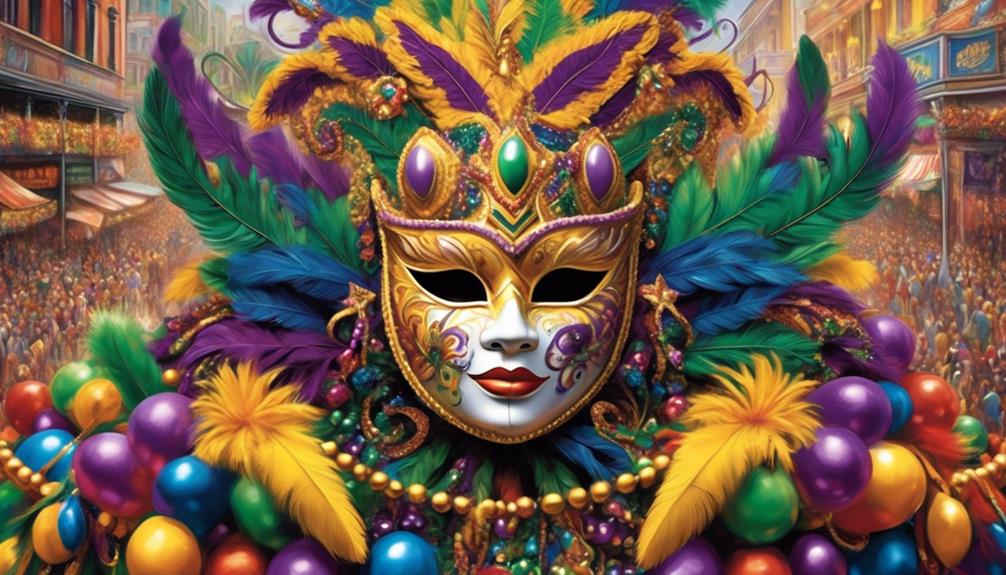
Walking down the lively streets of New Orleans amidst the Mardi Gras celebrations, decked out in vivid beads and masks, one could ponder whether there is a flag that truly captures the essence of this joyous festival.
The question of whether Mardi Gras has a flag is an intriguing one, especially considering the rich history and symbolism associated with this annual event.
While many are familiar with the flamboyant parades and lively music, the presence of a flag might not be immediately apparent. However, delving into the depths of Mardi Gras traditions and cultural significance may shed light on this enigmatic query.
Join us as we explore the captivating world of Mardi Gras symbolism and uncover the truth behind its potential flag.
Key Takeaways
- Mardi Gras has a rich and diverse symbolism that is reflected in every aspect of the celebration, including colors, masks, and beads.
- Flags play an important role in Mardi Gras as they represent the cultural, historical, and religious significance of the festival, while also serving as a means of unity, communication, and navigation.
- Mardi Gras flags have evolved over time, from early flags with club emblems to modern flags with unity themes, celebrating diversity, cultural heritage, and community.
- Other significant symbols in Mardi Gras culture include the Rex flag, Zulu coconut flag, Comus flag, Mardi Gras Indian flag, and Krewe flag, each showcasing different aspects of the festival's traditions and history.
Origins of Mardi Gras
The origins of Mardi Gras can be traced back to medieval Europe, where it began as a Christian tradition marking the beginning of Lent. The term 'Mardi Gras' is French for 'Fat Tuesday,' the day before Ash Wednesday. This day was a time for people to indulge in rich and fatty foods before the Lenten period of fasting and reflection. Over time, Mardi Gras evolved into a vibrant and festive celebration, particularly in regions with strong French Catholic influences, such as New Orleans.
The cultural significance of Mardi Gras is deeply rooted in the traditions of the communities that celebrate it. It has become a time for people to come together, indulge in food and drink, and revel in the joyous festivities before the solemn observance of Lent. The colorful and elaborate flag designs associated with Mardi Gras often incorporate traditional symbols such as masks, beads, and the fleur-de-lis, representing the rich cultural tapestry of the celebration. These flags serve as visual representations of the exuberant spirit and unity of Mardi Gras celebrations.
Evolution of Mardi Gras Traditions

As Mardi Gras celebrations spread across different regions, they underwent significant transformations, incorporating diverse cultural influences and evolving into a multifaceted tapestry of traditions and customs. The evolution of Mardi Gras traditions has been a fascinating journey, shaped by historical, social, and cultural dynamics.
Here are some key aspects that highlight the evolution of Mardi Gras traditions:
- Cultural Significance: Mardi Gras has adapted and integrated elements from various cultures, such as French, Spanish, African, and Native American, creating a rich and diverse heritage that reflects the multicultural essence of the communities where it's celebrated.
- Community Engagement: Over time, Mardi Gras has become more than just a celebration; it has evolved into a platform for community engagement, fostering a sense of unity and belonging among diverse groups of people. Parades, balls, and other festivities have become integral parts of community life, promoting social cohesion and solidarity.
- Incorporation of New Elements: The traditions have continuously evolved by incorporating new elements, such as music genres, dance styles, and culinary traditions, enriching the overall Mardi Gras experience and keeping it relevant to contemporary society.
- Symbolism in Parades: The symbolism embedded in Mardi Gras parades has evolved to represent a broader array of themes, including social issues, historical events, and cultural diversity, reflecting the changing values and concerns of the communities.
- Modern Interpretations: While rooted in history, Mardi Gras traditions have also embraced modern interpretations, adapting to contemporary sensibilities while preserving their cultural essence.
Symbolism in Mardi Gras Culture
The symbolism in Mardi Gras culture is rich and diverse, permeating every aspect of the celebration.
From the colors of the flag to the representations of different cultural elements, each symbol holds deep meaning and significance.
Understanding the symbolism in Mardi Gras culture provides insight into the traditions and values that are cherished by the community.
Flag Symbolism
Embedded within the vibrant fabric of Mardi Gras culture, the symbolism of flags serves as a powerful conduit for expressing the rich history and diverse traditions of this lively celebration. The flag representation in Mardi Gras holds immense cultural significance, as it reflects the unique heritage, values, and identity of various communities participating in the festivities.
Here are some essential aspects of flag symbolism in Mardi Gras culture:
- Colors and Patterns: Flags often feature vibrant colors and intricate patterns that symbolize the energy and creativity of the Mardi Gras celebration.
- Historical References: Many flags incorporate historical symbols and motifs that pay homage to the diverse cultural influences that have shaped Mardi Gras traditions.
- Community Pride: Flags are used to showcase community pride, unity, and solidarity during Mardi Gras parades and events.
- Symbolic Representations: Flags often bear symbols that represent specific aspects of Mardi Gras culture, such as music, dance, and culinary delights.
- Identity and Tradition: Flags serve as visual representations of the unique identity and traditional values of different Mardi Gras krewes and organizations.
Cultural Representations
Cultural representations in Mardi Gras culture convey profound symbolism and serve as dynamic expressions of the diverse traditions and heritage integral to this vibrant celebration.
Flag designs, in particular, play a significant role in representing various aspects of Mardi Gras. The colors, patterns, and symbols on Mardi Gras flags often reflect the rich history and cultural influences of the communities that participate in the festivities.
For instance, the traditional purple, green, and gold colors on the flags symbolize justice, faith, and power, respectively. Additionally, intricate designs featuring masks, musical instruments, and iconic landmarks showcase the artistic and musical heritage of New Orleans and other regions where Mardi Gras is celebrated.
These flag designs not only add visual splendor to the celebration but also serve as meaningful cultural markers, connecting participants to their collective history and identity.
Importance of Flags in Festivals
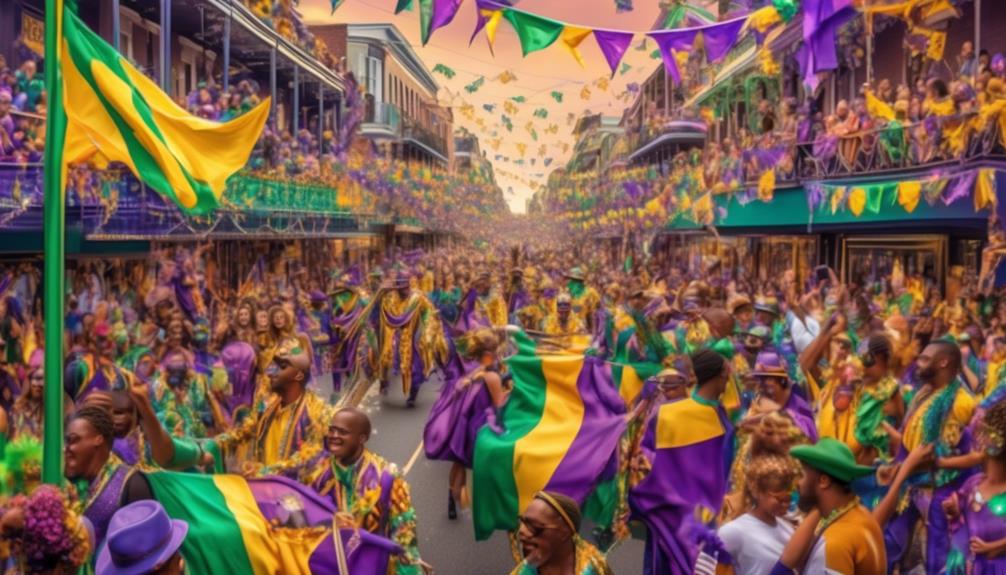
Celebrating festivals with colorful flags adds a vibrant and festive atmosphere, enhancing the overall experience for participants and spectators alike. Flags play a crucial role in festivals for several reasons:
- Symbolism: Flags often bear symbols and colors that represent the cultural, historical, or religious significance of the festival, providing a visual representation of the event's essence.
- Unity and Identity: Flags unite participants and spectators, creating a sense of belonging and pride in shared traditions and values, fostering a strong community spirit.
- Navigation and Communication: In large festival settings, flags can serve as landmarks, helping attendees navigate through the bustling crowds. They can also convey important messages or instructions.
- Historical Preservation: Many festival flags are steeped in tradition and history, serving as a link to the past and honoring the legacy of the event and its participants.
- Aesthetic Appeal: The colorful and varied display of flags adds to the overall visual spectacle of the festival, creating an enchanting and picturesque backdrop for all to enjoy.
Flags aren't merely decorative; they're powerful symbols that enrich the festival experience, communicate meaning, and foster a sense of unity and tradition.
Historical Flags Associated With Mardi Gras
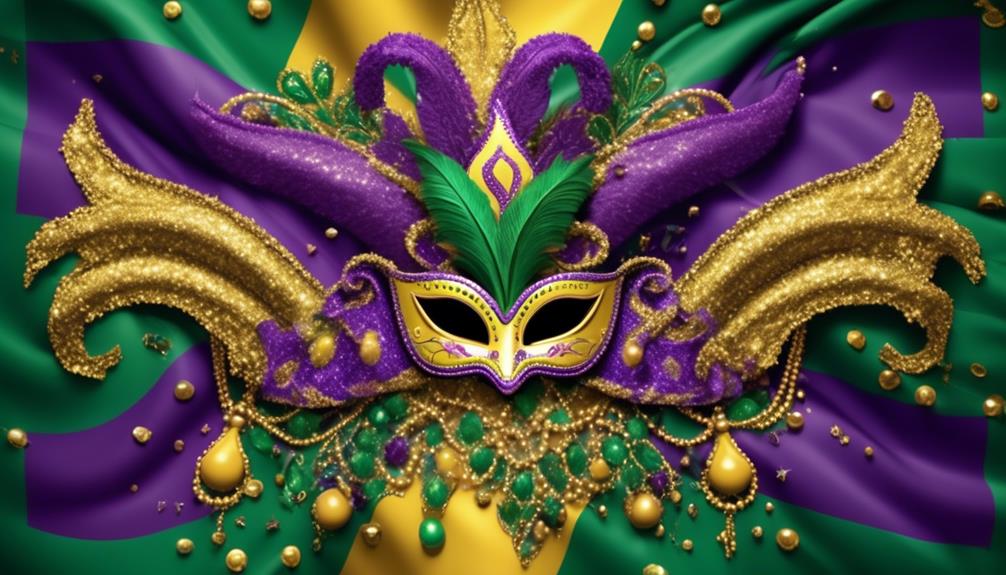
When exploring the historical flags associated with Mardi Gras, it's fascinating to examine the symbolic significance behind these vibrant banners.
As we look back at the evolution of Mardi Gras flags, we can gain insights into the changing cultural and social dynamics that have shaped this festive tradition.
Understanding the historical context of these flags allows us to appreciate the rich tapestry of traditions and symbolism woven into the fabric of Mardi Gras celebrations.
Symbolic Mardi Gras Flags
Throughout history, various flags have held significant symbolic meaning during Mardi Gras celebrations, representing the diverse cultural influences and traditions associated with this festive event. When exploring the cultural significance of Mardi Gras flags, it's essential to consider the historical context and the fusion of various cultural elements.
The following historical flags associated with Mardi Gras provide insight into the rich tapestry of traditions and symbolism:
- Rex flag: The official flag of the Rex organization, representing the monarch of Mardi Gras.
- Zulu coconut flag: Symbolizing the unique tradition of throwing hand-decorated coconuts to parade-goers.
- Comus flag: Reflecting the mystic and mythological themes often seen in Mardi Gras celebrations.
- Mardi Gras Indian flag: Showcasing the vibrant and intricate designs of the Mardi Gras Indian tribes.
- Krewe flag: Illustrating the diverse themes and motifs chosen by different krewes to represent their unique identities.
Evolution of Mardi Gras Flags
The evolution of Mardi Gras flags reflects the dynamic cultural amalgamation and historical development of this vibrant celebration, encompassing a diverse array of symbolic representations and traditions. Mardi Gras flags have evolved over time, mirroring the changing social and cultural landscape of the communities that celebrate this festive occasion. These flags carry deep symbolism, representing the rich tapestry of traditions, values, and historical influences that have shaped Mardi Gras. From the early flags that bore the emblems of various social clubs and organizations to the modern designs reflecting the spirit of unity and celebration, the evolution of Mardi Gras flags showcases the resilience and adaptability of this cherished tradition.
| Evolution of Mardi Gras Flags | Symbolism |
|---|---|
| Early flags with club emblems | Representation of social clubs and organizational affiliations |
| Intricate designs and vibrant colors | Celebration of diversity and cultural heritage |
| Modern flags with unity themes | Emphasis on community and collective joy |
Contemporary Symbols of Mardi Gras

In today's Mardi Gras celebrations, the vibrant and distinctive Mardi Gras flag has emerged as a prominent contemporary symbol, embodying the spirit and exuberance of this festive occasion. The Mardi Gras flag represents the rich cultural heritage and traditions of the event, serving as a unifying emblem for participants and spectators alike.
Here are five contemporary symbols of Mardi Gras:
- Colorful Beads: Symbolizing the tradition of bead-throwing during Mardi Gras parades, these vibrant strands are a popular and recognizable symbol of the celebration.
- Masks: Intricately designed masks aren't only a traditional part of Mardi Gras attire but also serve as a contemporary symbol of the event, representing the mystery and revelry of the occasion.
- Floats: Elaborate, themed floats have become a modern symbol of Mardi Gras, showcasing creativity and artistry while parading through the streets of New Orleans and other cities.
- King Cake: This sweet, circular pastry, often decorated in the traditional Mardi Gras colors of purple, green, and gold, has become a contemporary symbol of the culinary delights associated with the festival.
- Music: The lively and rhythmic music of Mardi Gras, particularly jazz and brass bands, serves as a contemporary symbol of the event, infusing the atmosphere with energy and joy.
Potential Flag Designs for Mardi Gras
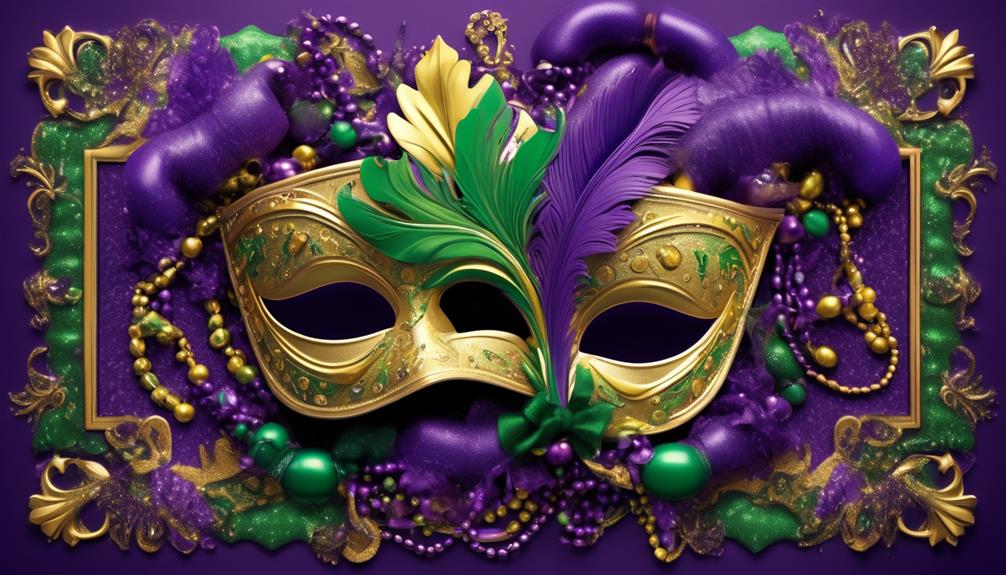
After examining the vibrant and distinctive symbols associated with Mardi Gras, we're now delving into the exploration of potential flag designs that encapsulate the essence and spirit of this lively celebration.
When considering flag designs for Mardi Gras, it's crucial to integrate the symbolic elements that represent the cultural significance and historical traditions of this festive occasion.
One potential flag design could feature the traditional Mardi Gras colors of purple, green, and gold, which hold specific meanings: purple for justice, green for faith, and gold for power. These colors could be arranged in a way that reflects the joyful and exuberant atmosphere of Mardi Gras. Additionally, incorporating iconic symbols such as masks, fleur-de-lis, and musical instruments like trumpets and saxophones could further enhance the flag's representation of Mardi Gras.
Another approach to designing a Mardi Gras flag could involve drawing inspiration from historical flags used during the celebration. For instance, the incorporation of historical symbols such as the Rex organization's emblem, the Crown and Scepter, or the Comus organization's emblem, the Butterfly, could add a sense of tradition and heritage to the flag design.
In essence, potential flag designs for Mardi Gras should aim to authentically capture the cultural richness and symbolic significance of this beloved celebration.
Cultural Significance of Mardi Gras Symbols
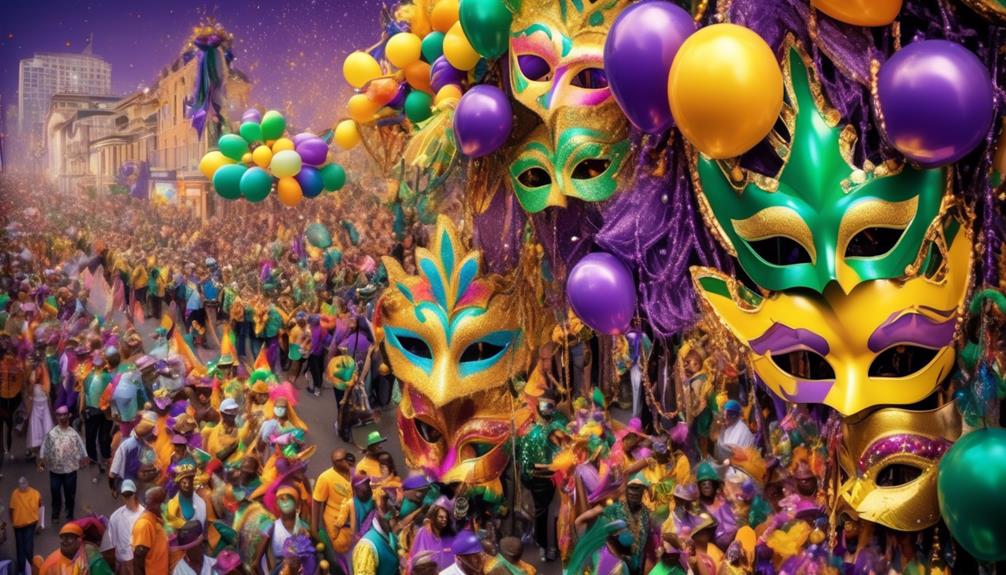
Exploring the cultural significance of Mardi Gras symbols reveals a rich tapestry of traditions, meanings, and historical contexts that contribute to the vibrant essence of this festive celebration. Mardi Gras symbols hold deep symbolic representation, encapsulating the cultural heritage and historical roots of the event. The iconic imagery and traditional significance associated with these symbols play a pivotal role in shaping the identity of Mardi Gras, fostering a sense of community and tradition among its participants.
Here are some key aspects of the cultural significance of Mardi Gras symbols:
- Colors: The traditional colors of Mardi Gras, purple, green, and gold, symbolize justice, faith, and power, respectively, and reflect the values upheld during this celebration.
- Masks: Beyond their aesthetic appeal, masks serve as a symbol of freedom and equality during Mardi Gras, allowing individuals to shed societal constraints and embrace their true selves.
- Beads: These colorful beads represent the spirit of generosity and camaraderie, as they're joyfully shared among revelers during the festivities.
- King Cake: This sweet treat holds great cultural significance, concealing a small figurine representing luck and prosperity, adding an element of surprise and tradition to the celebrations.
- Music and Dance: The lively music and spirited dance performances during Mardi Gras embody the exuberant and jubilant nature of the event, fostering a sense of unity and joy among participants.
Debunking Myths About Mardi Gras Flags
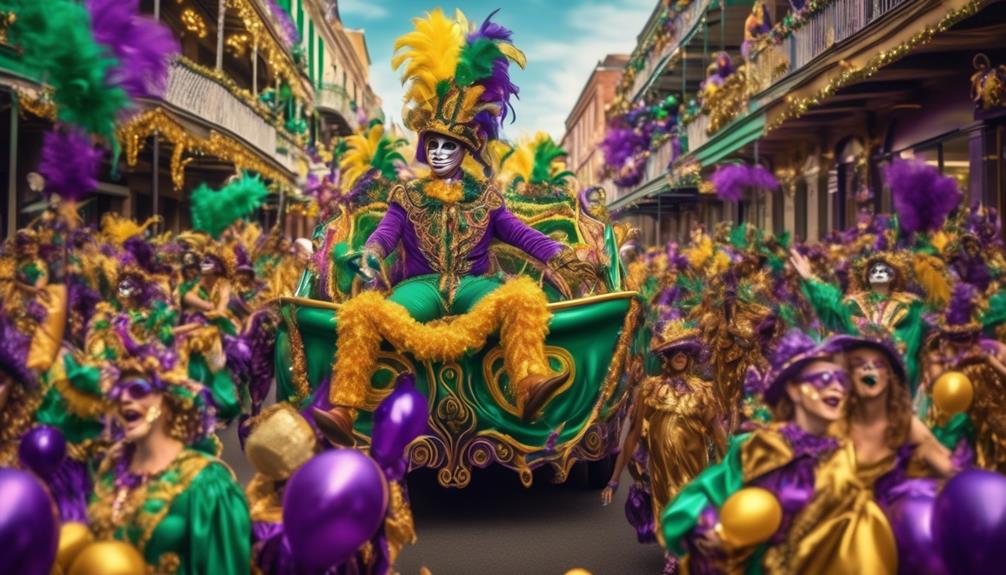
As we explore the intricacies of Mardi Gras flags, it's essential to debunk common myths surrounding their origin, symbolism, and design variations.
By addressing misconceptions about the Mardi Gras flag, we can gain a deeper understanding of its cultural significance and historical context.
This discussion will shed light on the true essence of the Mardi Gras flag and its role in the vibrant celebration.
Mardi Gras Flag Origin
How did the Mardi Gras flag truly originate, and what common myths about Mardi Gras flags can be debunked through historical analysis and cultural context?
The Mardi Gras flag history is rich and diverse, with its design evolution reflecting the cultural amalgamation of the festival. Through historical analysis, we can debunk the myth that the Mardi Gras flag has always had a static design. The truth is that the flag's design has evolved over time, influenced by various cultural and historical factors. It's essential to consider the deep-rooted traditions and symbolism associated with Mardi Gras when exploring the origins of its flag.
- The influence of different cultural groups on the design
- The evolution of flag symbolism over time
- Historical events shaping the flag's design
- The significance of colors and patterns
- The role of Mardi Gras in preserving cultural heritage
Symbolism of Mardi Gras
The evolution of the Mardi Gras flag design over time reflects the rich symbolism embedded within the festival, providing insights that debunk common myths about Mardi Gras flags.
The vibrant Mardi Gras colors of purple, green, and gold aren't just random choices but hold deep significance. Purple represents justice, green symbolizes faith, and gold signifies power. These colors are prominently featured in Mardi Gras flags, conveying the values and spirit of the festival.
Additionally, traditional costumes worn during Mardi Gras celebrations also play a significant role in the symbolism of the event. The elaborate and colorful costumes reflect the festive and lively nature of Mardi Gras, emphasizing the celebration of life and community.
These symbols illustrate the essence of Mardi Gras, dispelling misconceptions about the festival and its flags.
Flag Variations and Designs
Exploring the intricate variations and designs of Mardi Gras flags reveals the fascinating history and cultural significance behind these vibrant symbols, offering a deeper understanding that dispels common misconceptions.
Mardi Gras flags have evolved over time, drawing inspiration from diverse sources such as European heraldry, African textiles, and Native American art. The flag's colors and patterns often represent the rich tapestry of cultures that have shaped the Mardi Gras tradition.
Designs may feature traditional Mardi Gras symbols like fleur-de-lis, masks, and musical instruments, each holding its own historical and symbolic significance. Flag history is deeply intertwined with the complex social and religious roots of Mardi Gras, reflecting the spirit of celebration and unity.
The evolution of these designs mirrors the ever-changing cultural landscape, demonstrating the enduring relevance of Mardi Gras flags.
Community Engagement With Mardi Gras Symbols
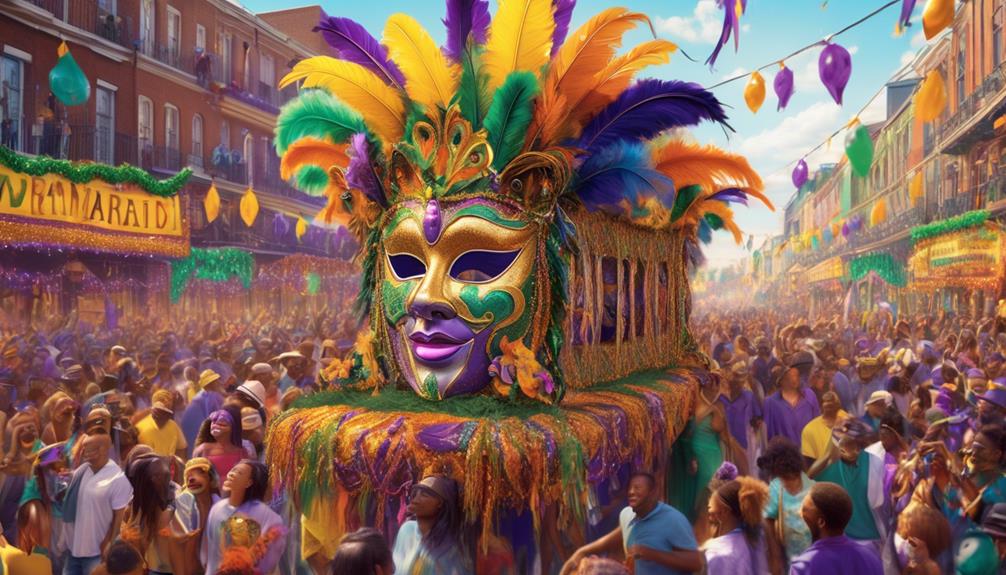
Engaging with Mardi Gras symbols fosters a sense of community pride and celebration, as individuals come together to embrace the rich cultural heritage and traditions associated with the festival. Community engagement with Mardi Gras symbols is integral to the festival's representation and the fostering of a shared identity among its participants. Through active involvement with these symbols, the community not only celebrates its history but also reinforces the values and customs that define the festival.
| Symbol | Meaning | Importance |
|---|---|---|
| Mardi Gras Colors (Purple, Green, Gold) | Represent justice, faith, and power, respectively | Unites the community under shared values |
| Mardi Gras Beads | Symbol of celebration and camaraderie | Encourages interaction and inclusivity |
| Mardi Gras Masks | Reflect historical tradition and anonymity | Fosters a sense of mystery and collective excitement |
| King Cake | Symbolizes the search for the baby Jesus | Encourages participation in festive traditions |
Future of Mardi Gras Symbolism

As we contemplate the future of Mardi Gras symbolism, we must consider the evolving significance of these cherished symbols within the context of modern cultural dynamics and societal shifts. Symbolic representation holds immense power in shaping identity and fostering community cohesion. Modern interpretations of Mardi Gras symbolism are crucial in ensuring its relevance and inclusivity for future generations. Here are some key considerations:
- Cultural Appropriation: We must navigate the fine line between celebrating Mardi Gras traditions and respecting the cultural origins of its symbols.
- Inclusivity: As societal norms evolve, it's essential to ensure that Mardi Gras symbolism reflects the diversity and inclusivity of the communities it represents.
- Environmental Consciousness: With growing environmental awareness, the future of Mardi Gras symbolism may involve sustainable and eco-friendly practices.
- Digital Engagement: The use of technology and social media platforms can enhance the reach and impact of Mardi Gras symbolism, inviting broader participation.
- Historical Preservation: While embracing modern interpretations, it's vital to preserve the historical significance of Mardi Gras symbols and rituals, ensuring their legacy for future generations.
Frequently Asked Questions
What Are the Typical Colors Used in Mardi Gras Flags?
Typical colors for Mardi Gras flags include vibrant shades like purple, green, and gold. These colors hold symbolic significance, representing justice, faith, and power.
Symbolic motifs often feature fleur-de-lis, masks, and musical instruments to embody the festive spirit of Mardi Gras.
The combination of these colors and motifs creates a visually striking and culturally rich representation of the celebration.
Are There Any Specific Rules or Guidelines for Designing a Mardi Gras Flag?
When designing a Mardi Gras flag, there are cultural guidelines to consider. The colors, like purple for justice and gold for power, hold significant meaning.
Symbolism in the design should reflect the festive spirit and the spirit of New Orleans. Traditional elements, like fleur-de-lis or masks, can be incorporated creatively.
It's a unique opportunity to honor the rich traditions and celebrate the vibrant culture of Mardi Gras.
How Do Mardi Gras Flags Differ From Flags Used in Other Festivals or Events?
Mardi Gras flags stand out due to their vibrant colors, intricate designs, and cultural significance. In comparison to flags used in other festivals, Mardi Gras flags often display symbols of the event's historical evolution and the rich cultural heritage of New Orleans.
These flags aren't just decorative; they serve as powerful symbols of community pride and celebration. The symbolism and historical evolution embedded in Mardi Gras flags set them apart from flags used in other events.
Are There Any Traditional Symbols or Motifs That Are Commonly Found on Mardi Gras Flags?
Traditional symbols and motifs on Mardi Gras flags hold immense cultural significance. They depict vibrant imagery, reflecting the spirit of the festival. Flag design guidelines emphasize bold colors and intricate detailing.
Regional variations and community traditions further enrich the diversity of these flags. Each symbol and motif tells a unique story, celebrating the rich heritage and traditions of Mardi Gras.
Do Different Regions or Communities Have Their Own Unique Flag Designs for Mardi Gras?
In exploring regional variations, it's fascinating to note the diverse flag symbolism seen in Mardi Gras celebrations. Different communities often incorporate unique designs and colors that reflect local traditions and cultural influences. These variations add depth and richness to the overall tapestry of Mardi Gras, showcasing the creativity and individuality of each region.
The flag designs serve as a visual representation of the community's distinct identity and heritage, enhancing the festive spirit of the occasion.
Conclusion
In conclusion, it's clear that Mardi Gras doesn't have a flag, but that doesn't stop us from imagining what it would look like.
Picture a vibrant flag adorned with beads, masks, and feathers, waving proudly in the midst of a colorful parade.
While the tradition of a Mardi Gras flag may not exist, the symbolism and spirit of the festival continue to thrive in the hearts and minds of its celebrants.
- About the Author
- Latest Posts
Introducing Ron, the home decor aficionado at ByRetreat, whose passion for creating beautiful and inviting spaces is at the heart of his work. With his deep knowledge of home decor and his innate sense of style, Ron brings a wealth of expertise and a keen eye for detail to the ByRetreat team.
Ron’s love for home decor goes beyond aesthetics; he understands that our surroundings play a significant role in our overall well-being and productivity. With this in mind, Ron is dedicated to transforming remote workspaces into havens of comfort, functionality, and beauty.
Mardi Gras Decoration
What to Do With Mardi Gras Doubloons?

After the end of Mardi Gras season, many of us have a surplus of vibrant doubloons.
But what to do with these shimmering tokens of celebration? Well, we could turn doubloons into wearable art, transform them into home decor, incorporate them into crafts and DIY projects, donate them to charity, or create beautiful doubloon shadow boxes to preserve memories.
The possibilities are endless, and the decision of what to do with these tokens can be both practical and meaningful.
Key Takeaways
- Mardi Gras doubloons can be repurposed into wearable art such as jewelry and accessories, adding festivity and tradition to everyday fashion.
- Doubloons can be used in various home decor projects, including creating vibrant art pieces, crafting garlands, and making striking wall art.
- Incorporating doubloons into crafts and DIY projects can add a festive and colorful spirit, promoting sustainability through upcycling.
- Donating doubloons to charity can make a direct and positive impact on those in need, spreading joy throughout the year.
Turn Doubloons Into Wearable Art
We can transform Mardi Gras doubloons into unique wearable art pieces by incorporating them into jewelry, accessories, or clothing designs. Doubloon jewelry offers a stunning way to repurpose these tokens, allowing individuals to wear a piece of Mardi Gras history. By carefully crafting doubloons into earrings, pendants, or bracelets, we can create timeless pieces that evoke the spirit of celebration and community. These jewelry pieces not only serve as beautiful adornments but also carry the rich cultural significance of Mardi Gras.
Additionally, doubloons can be utilized to create distinctive accessories. From embellishing handbags and hats to adorning belts and shoes, doubloon accessories add a touch of flair and individuality to any ensemble. By incorporating these tokens into accessories, we can infuse a sense of festivity and tradition into everyday fashion, enabling individuals to carry a piece of Mardi Gras with them wherever they go.
Transform Doubloons Into Home Decor
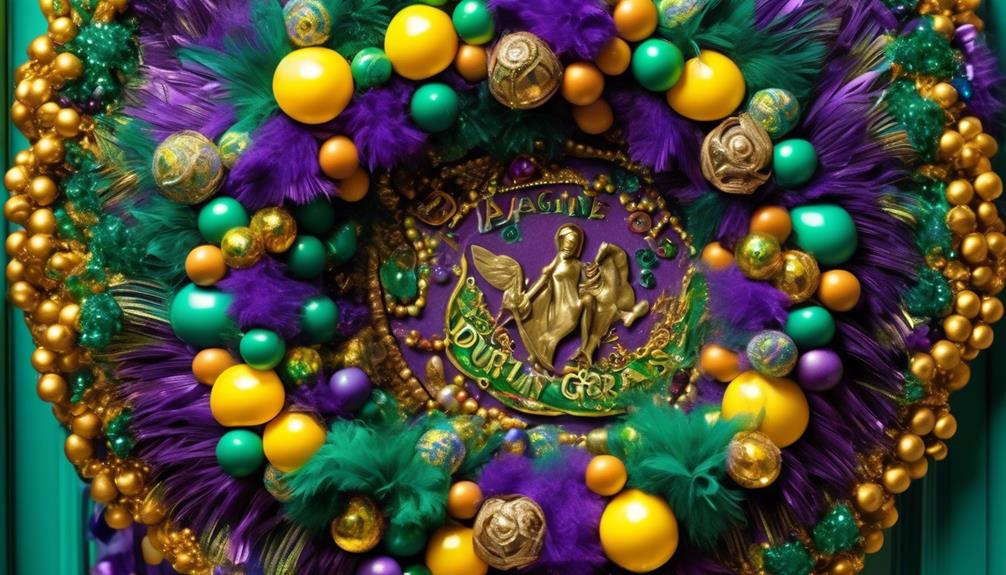
How can Mardi Gras doubloons be repurposed to create unique and captivating home decor pieces?
Upcycling ideas for Mardi Gras doubloons can turn these festive trinkets into eye-catching decorations for your home. Here are four creative display ideas to transform doubloons into stunning decor pieces:
- Shadow Box Art: Arrange a collection of colorful doubloons in a shadow box frame to create a vibrant and dynamic art piece. By arranging the doubloons in a visually appealing pattern, you can showcase the festive spirit of Mardi Gras in a sophisticated and elegant manner.
- Doubloon Garland: String together a series of doubloons to craft a stunning garland that can be draped along a mantelpiece, staircase, or doorway. This DIY garland adds a touch of Mardi Gras flair to any room and serves as a unique conversation starter for guests.
- Doubloon Coasters: Glue doubloons onto cork coasters to create striking and functional decor pieces. These coasters not only protect your furniture but also add a pop of color to your living space.
- Doubloon Wall Art: Create a captivating mosaic or pattern on a canvas using an assortment of doubloons. This striking wall art piece celebrates the festive spirit of Mardi Gras and adds a touch of whimsy to your home decor.
Incorporate Doubloons Into Crafts and DIY Projects
Incorporating Mardi Gras doubloons into various crafts and do-it-yourself (DIY) projects provides an opportunity to infuse a festive and colorful spirit into creative endeavors, enhancing the visual appeal of the final products.
Upcycling doubloons through creative reuse not only adds a touch of New Orleans' vibrant culture but also promotes sustainability by giving these coins a new lease on life.
One innovative way to integrate doubloons into crafts is by using them as embellishments for handmade jewelry such as earrings, necklaces, or bracelets. By adding doubloons as unique charms or pendants, you can create one-of-a-kind accessories that celebrate the spirit of Mardi Gras.
Another creative DIY project could involve using doubloons to decorate picture frames, creating eye-catching displays for cherished memories.
Additionally, incorporating these coins into mosaic art or mixed media collages can add an element of surprise and whimsy to your creations.
Share the Joy: Donate Doubloons to Charity
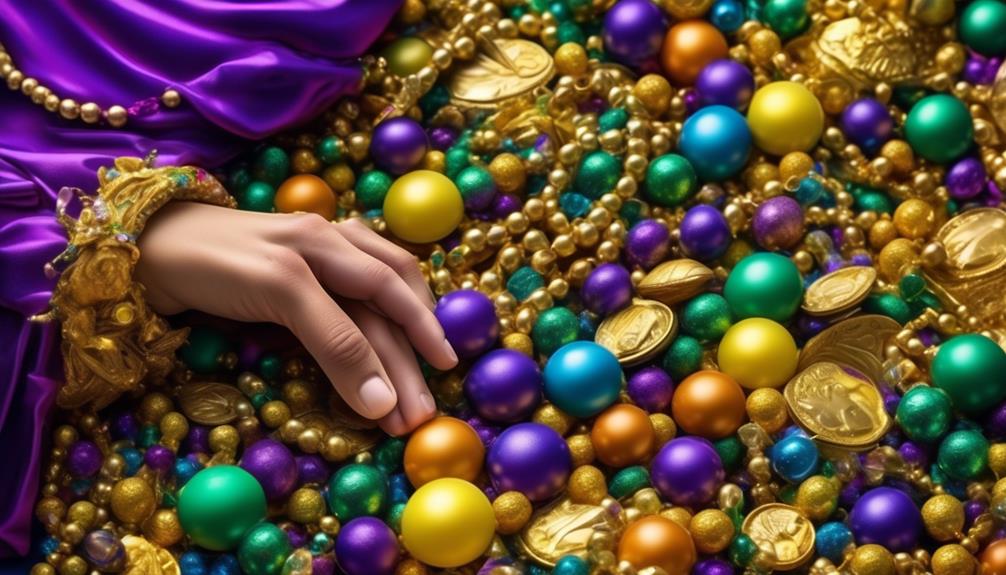
Consider donating Mardi Gras doubloons to charity as a meaningful way to spread the festive spirit and support community causes. It's a simple yet impactful gesture that can make a difference in the lives of others.
Here are some compelling reasons to consider donating your doubloons to charity:
- Fundraising ideas: Many charitable organizations use creative opportunities to raise funds, and your doubloons could contribute to their efforts. Whether it's through auctions, raffles, or themed events, your donation can help these organizations support their causes.
- Community involvement: By donating your doubloons to charity, you're actively engaging with and supporting your community. Your contribution can inspire others to get involved as well, fostering a sense of togetherness and shared purpose.
- Charitable impact: Your donated doubloons can have a direct and positive impact on those in need. Whether it's supporting local schools, healthcare initiatives, or social welfare programs, your contribution can help make a tangible difference in the lives of others.
- Spread joy: By donating your doubloons, you're spreading joy not only during Mardi Gras but also throughout the year. Your generosity can bring happiness to those benefiting from the charitable causes supported by your donation.
Preserve Memories: Create Doubloon Shadow Boxes
One effective way to preserve the memories of Mardi Gras is by creating shadow boxes to display and showcase your collection of colorful and festive doubloons. Custom framing provides an excellent way to protect and exhibit your doubloons while adding a touch of elegance to your display.
By carefully arranging your doubloons in a shadow box, you can create a visually appealing and meaningful piece of art that serves as a beautiful reminder of the joyous Mardi Gras celebrations. These shadow boxes become memory keepsakes, allowing you to cherish the spirit of Mardi Gras for years to come.
When creating your doubloon shadow box, consider the layout and organization of your collection. Arrange the doubloons in a way that tells a story or captures the essence of the festivities. Add decorative elements such as beads, feathers, or masks to enhance the visual appeal of the shadow box and evoke the lively atmosphere of Mardi Gras.
Custom framing also offers the opportunity to include captions or small trinkets that hold sentimental value, adding a personal touch to your display. By taking the time to create a well-crafted shadow box, you can preserve the vibrant memories of Mardi Gras and proudly showcase your collection.
Frequently Asked Questions
Where Can I Find Mardi Gras Doubloons to Use for These Projects?
We often find Mardi Gras doubloons in specialty stores, online marketplaces, and even at local parades. When seeking suppliers, consider exploring craft stores, party supply shops, and online platforms like Etsy or eBay.
For creative uses, consider incorporating doubloons into home decor or art projects. With a little creativity, doubloons can be transformed into eye-catching wall art, unique table centerpieces, or even incorporated into jewelry designs.
Are There Any Safety Concerns When Working With Mardi Gras Doubloons for Crafting and DIY Projects?
Safety precautions are crucial when working with Mardi Gras doubloons for crafting. It's important to ensure proper ventilation and use protective gear like gloves and goggles to prevent any injuries.
When crafting with doubloons, we recommend avoiding activities that involve sharp tools or heating elements to minimize potential hazards. Additionally, always supervise children to prevent accidental ingestion or choking.
Some fun and safe crafting ideas include creating jewelry, decorations, and mosaic art.
Can I Sell or Trade My Mardi Gras Doubloons Instead of Using Them for These Projects?
Selling or trading Mardi Gras doubloons instead of using them for crafting and DIY projects is a great way to share the festive spirit. It allows us to spread the joy of Mardi Gras while also giving others the chance to enjoy these unique tokens.
Plus, it can be a fun way to connect with fellow enthusiasts and collectors. Whether it's for a small craft or a grand event, the exchange of doubloons adds an extra layer of excitement to the celebration.
Are There Any Specific Charities or Organizations That Accept Mardi Gras Doubloons as Donations?
We've found that some charitable organizations may accept Mardi Gras doubloons as donations.
However, if you're feeling creative, upcycling the doubloons into unique crafts or jewelry can also be a wonderful way to repurpose them for a good cause.
As a group, we believe in the power of creative upcycling and giving back, so exploring these options could provide a meaningful way to make a positive impact.
How Can I Properly Store and Display My Doubloons in a Shadow Box to Preserve Their Condition?
Preserving memories is essential, and creating a DIY shadow box is a fantastic way to do it. When displaying doubloons, consider using a deep shadow box with a padded interior to protect them.
You can also incorporate decorative elements like fabric or themed backgrounds. This not only preserves their condition but also turns them into a beautiful display piece.
It's a wonderful way to honor the memories associated with these special tokens.
Conclusion
In conclusion, don't let those Mardi Gras doubloons collect dust in a drawer. Get creative and turn them into wearable art, home decor, or incorporate them into crafts and DIY projects.
And did you know that over 25 million doubloons are thrown during Mardi Gras celebrations each year? So put those doubloons to good use and share the joy by donating them to charity or preserving memories in shadow boxes.
Let the creativity flow!
- About the Author
- Latest Posts
Introducing Ron, the home decor aficionado at ByRetreat, whose passion for creating beautiful and inviting spaces is at the heart of his work. With his deep knowledge of home decor and his innate sense of style, Ron brings a wealth of expertise and a keen eye for detail to the ByRetreat team.
Ron’s love for home decor goes beyond aesthetics; he understands that our surroundings play a significant role in our overall well-being and productivity. With this in mind, Ron is dedicated to transforming remote workspaces into havens of comfort, functionality, and beauty.
Mardi Gras Decoration
What Are You Supposed to Drink on Fat Tuesday?
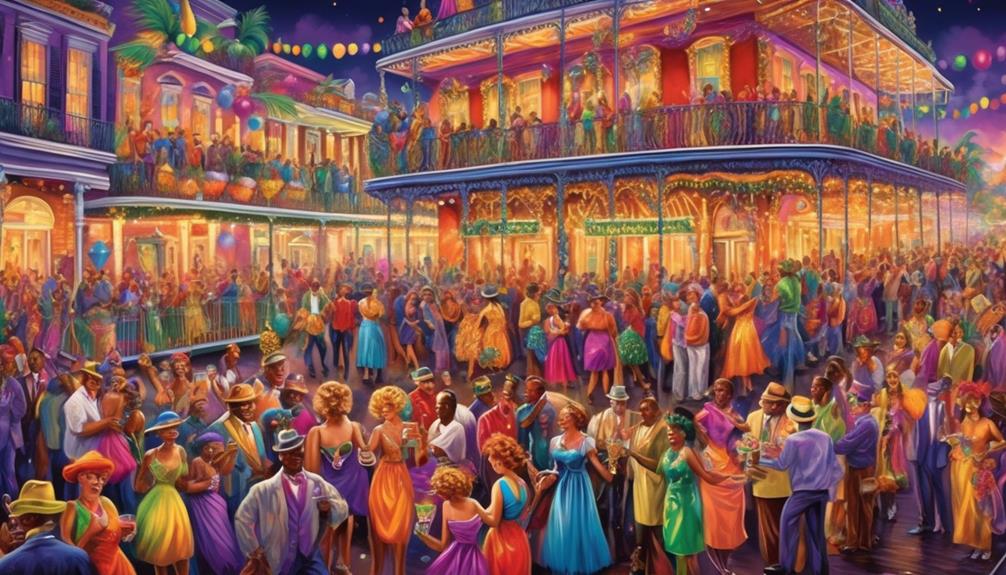
On Fat Tuesday, the traditional Mardi Gras colors of purple, green, and gold can be seen throughout the streets of New Orleans. But do these festive colors also appear in our drinks?
As we prepare to celebrate this festive occasion, we may find ourselves wondering what libations are best suited for the occasion. From the traditional cocktails of New Orleans to modern twists on classic drinks, the choices seem endless.
So, what are we supposed to drink on Fat Tuesday? Join us as we explore the rich history and vibrant flavors of Mardi Gras beverages, and discover how to create your own signature drink to elevate the festivities.
Key Takeaways
- Traditional Mardi Gras drinks include the Sazerac, Hurricane, Ramos Gin Fizz, Pimm's Cup, and Brandy Milk Punch.
- Mardi Gras beers such as Abita Mardi Gras Bock, Dixie Beer, NOLA Brewing Muses, Parish Brewing Co. Canebrake, and Urban South Brewery Holy Roller are popular choices for celebrating.
- Non-alcoholic Mardi Gras drinks like King Cake Milkshake, Mardi Gras Punch, Cajun Lemonade, Mardi Gras Mocktail, and Southern Sweet Tea offer festive options for those who don't consume alcohol.
- Wine pairings for Mardi Gras cuisine can include Zinfandel, Grenache, Riesling, Chardonnay, and Rosé to complement the flavors of dishes like gumbo, étouffée, and seafood.
The History of Mardi Gras Drinks
Mardi Gras drinks have been an integral part of the festive celebration, adding a vibrant and flavorful dimension to the rich history of this tradition. Historical origins of Mardi Gras drinks can be traced back to the early 18th century when French settlers brought their love for wine and brandy to Louisiana. These early libations laid the foundation for the diverse and spirited concoctions enjoyed during Mardi Gras today.
Cultural significance is deeply intertwined with Mardi Gras drinks. From the traditional Sazerac cocktail to the iconic Hurricane, each beverage carries with it a story of the region's cultural blend. The Sazerac, considered one of the world's oldest known cocktails, is a testament to the city's French heritage, while the Hurricane, with its blend of rum and fruit juices, is a nod to the city's close ties with the Caribbean.
Understanding the historical origins and cultural significance of Mardi Gras drinks adds to the overall experience of this joyous celebration. It allows us to appreciate the depth of tradition and the fusion of cultures that have contributed to the vibrant tapestry of Mardi Gras.
Iconic Cocktails of New Orleans
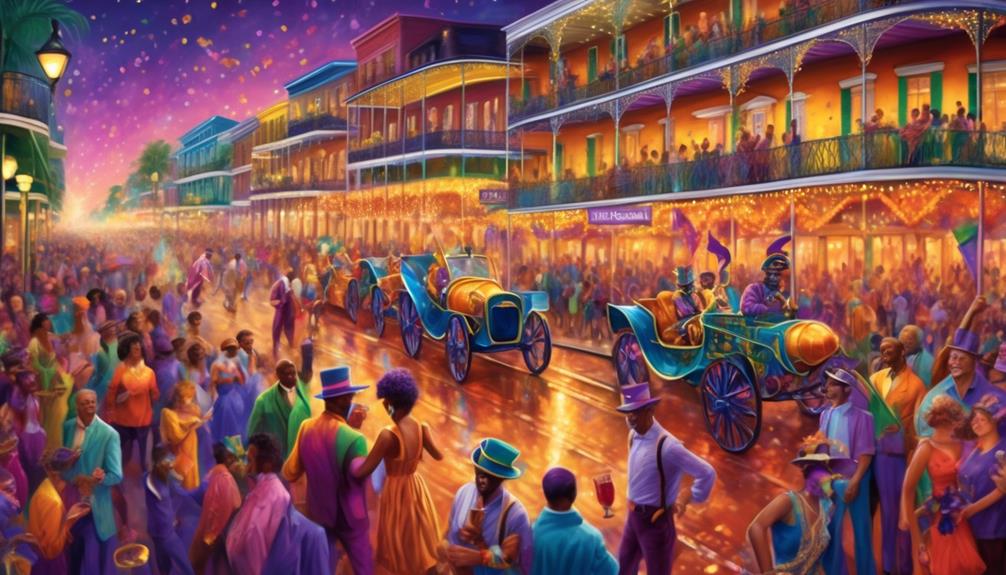
New Orleans is renowned for its iconic cocktails, each imbued with a rich history and distinct flavors that reflect the city's vibrant culture.
The cocktail culture in New Orleans is steeped in tradition, with many of the classic drinks dating back to the 19th century. One can't talk about iconic cocktails of New Orleans without mentioning the Sazerac, a timeless concoction that's considered the city's official cocktail. This historic libation, originating in the early 1800s, is a mix of rye whiskey or cognac, absinthe, Peychaud's Bitters, and a sugar cube.
Another quintessential New Orleans cocktail is the Vieux Carré, a potent and complex blend of rye whiskey, Cognac, sweet vermouth, and bitters.
Both of these cocktails can be enjoyed in the historic Bourbon Street bars, where the ambiance and history blend perfectly with the drinks. The Carousel Bar at Hotel Monteleone and the Old Absinthe House are just a couple of the many establishments where one can savor these iconic cocktails while soaking in the rich cocktail history of New Orleans.
Traditional Mardi Gras Beverages
For those looking to experience the traditional beverages of Fat Tuesday, a journey into the vibrant and spirited world of Mardi Gras libations awaits. When it comes to Mardi Gras punch recipes, the classic Hurricane cocktail is a must-try. This fruity concoction, with its blend of dark and light rum, passion fruit juice, and grenadine, captures the essence of the festivities in every sip. It's a delightful balance of sweet and tangy flavors that will transport you to the heart of New Orleans.
Another beloved punch option is the Sazerac, a potent blend of rye whiskey, absinthe, and bitters that packs a flavorful punch.
As for traditional beer selections, no Mardi Gras celebration is complete without a cold bottle of Abita. This Louisiana-based brewery offers a range of brews, including the iconic Abita Amber and Purple Haze, which are perfect for toasting to the revelry of Fat Tuesday.
Whether you're sipping on a refreshing beer or indulging in a vibrant Mardi Gras punch, these traditional beverages are sure to elevate your celebration to new heights.
Modern Twists on Classic Drinks
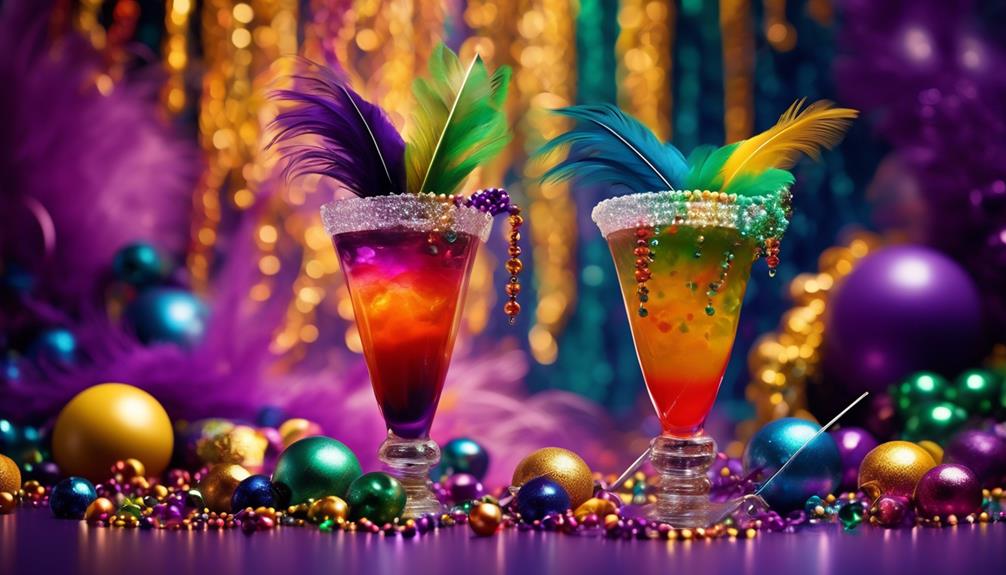
Get ready to elevate your Mardi Gras celebrations with updated cocktail recipes and innovative drink pairings.
We're shaking up classic libations with modern twists that bring a fresh and exciting vibe to your Fat Tuesday festivities.
From creative ingredient swaps to unexpected flavor combinations, these modern takes on traditional drinks are sure to impress and delight your guests.
Updated Cocktail Recipes
Looking to elevate your cocktail game with a modern twist on classic drinks? Here are some updated cocktail recipes that will add a fresh spin to your mixology repertoire:
- Spicy Margarita: Give your classic margarita a kick by adding a splash of jalapeno-infused tequila and a chili-salt rim for an extra fiery flavor.
- Berry Mojito: Shake up the traditional mojito by muddling fresh berries with mint leaves, adding a splash of berry-infused rum, and topping it off with a sparkling berry soda.
- Smoked Old Fashioned: Infuse your old fashioned with a smoky twist by using smoked bourbon and garnishing it with a charred orange slice.
- Coconut Espresso Martini: Add a tropical touch to the classic espresso martini by incorporating coconut cream and a toasted coconut rim.
- Cucumber Gin Fizz: Elevate the gin fizz by infusing it with refreshing cucumber and garnishing it with a cucumber ribbon for a sophisticated finish.
Innovative Drink Pairings
Let's shake up our cocktail game with innovative drink pairings, taking classic drinks to a whole new level with modern twists. For a delightful experience, consider these wine pairings and craft beer suggestions to elevate your Fat Tuesday celebration.
| Wine Pairings | Craft Beer Suggestions |
|---|---|
| Sparkling Rosé with | Belgian Witbier with |
| King Cake | hints of orange and |
| coriander | |
| Pinot Noir with | Chocolate Stout with |
| Cajun-spiced shrimp | rich, roasted flavors |
| and a velvety finish | |
| Riesling with | Saison with a fruity |
| Jambalaya | and spicy aroma |
These pairings are sure to add an exciting twist to your traditional Fat Tuesday celebration, enhancing the flavors and creating a memorable experience. Cheers to a festive and flavorful celebration!
Unique Regional Libations
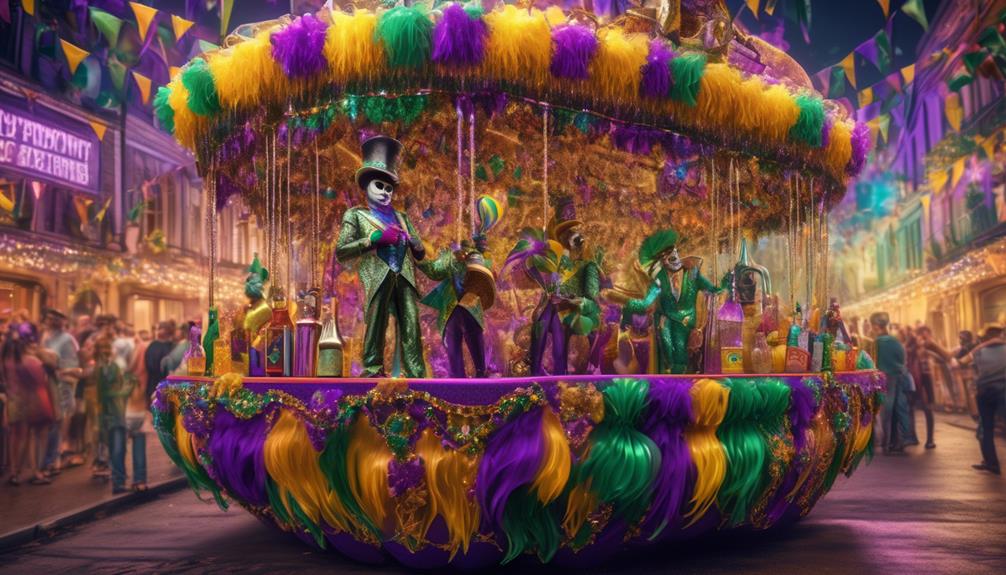
With Mardi Gras celebrations taking place across different regions, it's fascinating to explore the unique libations that are integral to each area's festive traditions. Regional variations in drinks add a special touch to the celebrations, reflecting the local culture and history.
- Hurricane – Originating from New Orleans, this rum-based cocktail with fruity flavors is a staple of Mardi Gras celebrations in the city. Its vibrant red color and sweet taste perfectly match the lively atmosphere of the festivities.
- Sazerac – Another iconic New Orleans drink, the Sazerac is a concoction of rye whiskey, absinthe, and bitters. It's a nod to the city's rich cocktail culture and is often enjoyed during Mardi Gras.
- King Cake Martini – In regions where king cake is a popular Mardi Gras treat, the King Cake Martini is a unique libation that captures the essence of the traditional dessert in liquid form, usually featuring vanilla vodka and colorful sugar rims.
- Mamou Mule – In Mamou, Louisiana, the Mamou Mule, a refreshing blend of vodka, ginger beer, and lime, is a go-to drink during the Courir de Mardi Gras festivities.
- Mint Julep – For Mardi Gras celebrations in regions influenced by French culture, such as Mobile, Alabama, the Mint Julep holds a special place. This classic Southern cocktail made with bourbon, sugar, water, and mint is a timeless favorite during the festivities.
Tips for Hosting a Mardi Gras Bar
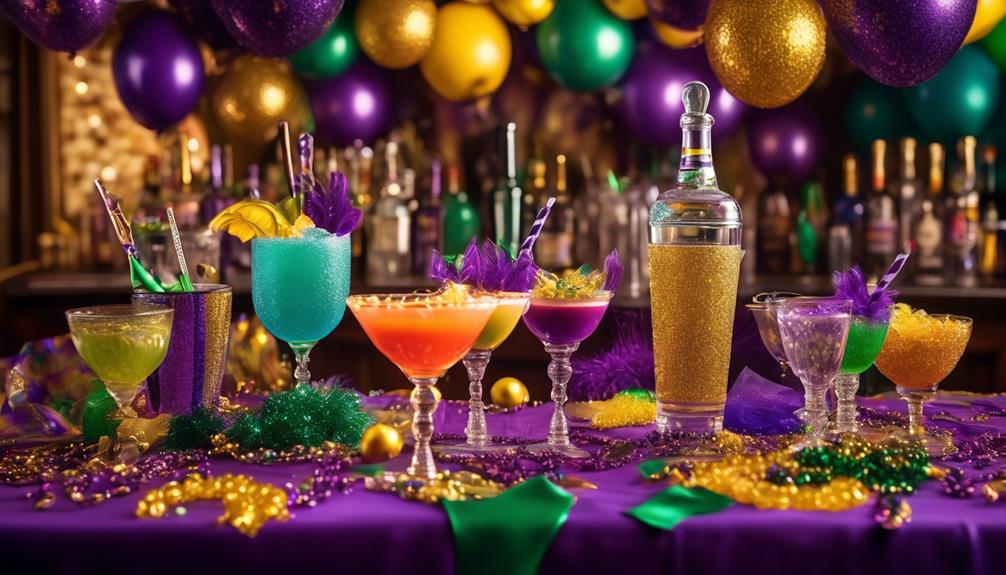
So, you're ready to throw an epic Mardi Gras bar?
Let's talk about cocktail recipe ideas, setting the ambience, and selecting the perfect beverages for the occasion.
We've got the inside scoop on how to make your Mardi Gras celebration one for the books.
Cocktail Recipe Ideas
Planning a Mardi Gras bar means concocting a delightful array of cocktail recipes that capture the festive spirit of Fat Tuesday. Here are some mixology tips and creative garnishes to make your drinks stand out:
- Bold Flavors: Experiment with seasonal ingredients like fresh berries, citrus fruits, and herbs to create vibrant and refreshing cocktails.
- Colorful Presentation: Use vibrant, Mardi Gras-inspired colors like purple, green, and gold for your cocktail garnishes and rimming sugars to add a festive touch.
- Traditional Twists: Put a creative spin on classic cocktails like the Hurricane or Sazerac by incorporating unique flavors and garnishes.
- Signature Drinks: Create signature cocktails for your Mardi Gras bar that reflect the spirit of the celebration and showcase your mixology skills.
- Mocktail Options: Offer non-alcoholic versions of popular cocktails for guests who prefer not to drink alcohol but still want to join in the fun.
Setting the Ambience
To create an authentic Mardi Gras experience at your bar, we focus on setting the ambience with vibrant decorations, lively music, and festive lighting.
Creating the right atmosphere is key. Start by adorning the bar with Mardi Gras-themed decor such as colorful beads, masks, and feather boas. These elements will transport your guests to the heart of New Orleans.
When it comes to music, think jazz, zydeco, and brass bands to infuse the space with the infectious energy of the French Quarter.
As for lighting, consider using strings of colorful lights or even LED candles to add a warm and inviting glow.
The combination of these elements will ensure that your Mardi Gras bar is a lively and enchanting space for all your revelers.
Selecting the Beverages
As we infuse the space with the infectious energy of the French Quarter through vibrant decorations, lively music, and festive lighting, our next focus turns to selecting the perfect beverages to complement the Mardi Gras experience at our bar.
- Craft Beer: Offer a selection of local craft beers to add a touch of authenticity and variety to the menu.
- Wine Pairings: Curate a range of wines that pair well with traditional Mardi Gras dishes, such as rich reds for gumbo or crisp whites for seafood.
- Signature Cocktails: Create specialty cocktails inspired by New Orleans classics, like the Sazerac or Hurricane, to add flair to the celebration.
- Mocktail Options: Ensure non-alcoholic options like fruity mocktails are available for designated drivers and those choosing not to drink.
- Champagne: Don't forget the bubbly! Champagne or sparkling wine adds a festive touch to toast the occasion.
Non-Alcoholic Options for All Ages
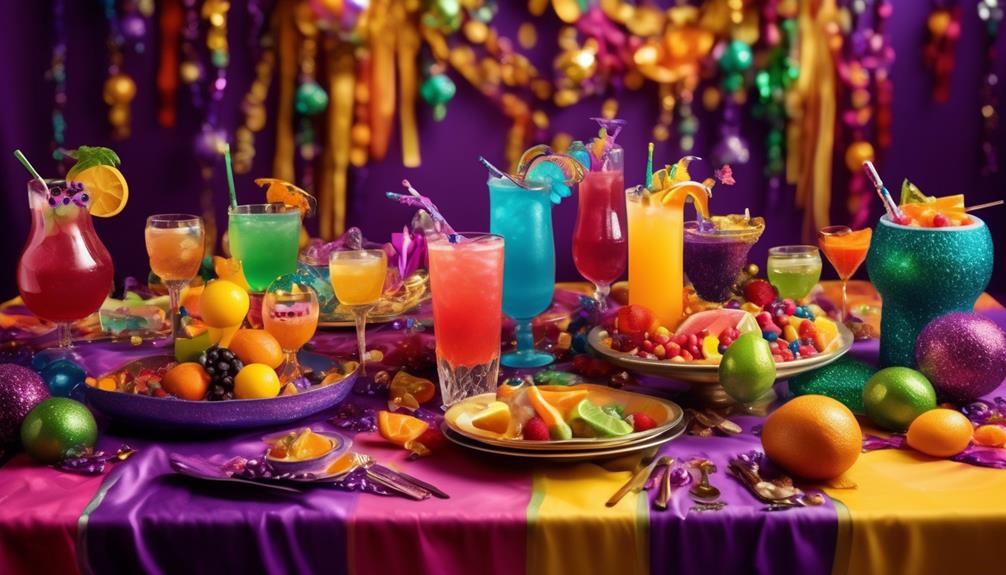
Amidst the festivities of Fat Tuesday, it's essential to have a variety of non-alcoholic options available for all ages to enjoy. Whether you're planning a family-friendly Mardi Gras party or simply prefer alcohol-free beverage options, there are plenty of delicious mocktail recipes to add to your celebration. Here are some alcohol-free options that will keep everyone in good spirits:
| Mocktail Name | Ingredients | Description |
|---|---|---|
| Virgin Pina Colada | Pineapple juice, coconut cream, ice | A tropical delight perfect for all ages |
| Sparkling Lemonade | Lemon juice, sparkling water, sugar | Refreshing and zesty, ideal for a hot day |
| Berry Spritzer | Mixed berry juice, club soda, fresh berries | A fruity and bubbly concoction that's a hit with kids |
These alcohol-free beverages are not only delicious but also add a touch of festivity to your Mardi Gras celebration. So, whether you're sipping on a Virgin Pina Colada or toasting with a Sparkling Lemonade, these mocktails are sure to be a hit with guests of all ages.
Pairing Drinks With Mardi Gras Cuisine

When delving into the vibrant flavors of Mardi Gras cuisine, we find ourselves seeking the perfect drink pairings to elevate the festive experience. As we indulge in the rich and spicy Creole and Cajun dishes, finding the right beverages to complement these robust flavors is essential.
Here are some delightful pairings to consider:
- Mardi Gras Beer Pairings: The bold and flavorful dishes of Mardi Gras cuisine call for beers that can stand up to the intense flavors. A hoppy IPA or a malty amber ale can be excellent choices to complement dishes like gumbo or jambalaya.
- Festive Wine Selections: For those who prefer wine, a medium-bodied red like a Zinfandel or a fruity Grenache can harmonize beautifully with the savory and spicy notes of dishes like étouffée or blackened fish. Additionally, a crisp and slightly sweet Riesling can balance the heat of Cajun spices.
Pairing the right drinks with Mardi Gras cuisine can truly enhance the celebration, bringing out the best in both the food and the beverages.
Cheers to a flavorful and festive Fat Tuesday!
Creating Your Own Mardi Gras Signature Drink

Diving into the spirited world of Mardi Gras cuisine and drinks, let's craft our own unique Mardi Gras signature drink to add a personal touch to the festive celebration.
When creating a signature Mardi Gras drink, mixology tips can elevate the experience. Start with a base of bourbon or rum for that classic New Orleans feel. Add in some fruity flavors like pineapple or mango to capture the essence of the tropics. Don't forget a splash of citrus with fresh lime juice to balance the sweetness.
Now, let's talk about the creative garnishes. A colorful array of sliced citrus fruits and maraschino cherries can add a festive and playful touch to your drink. For an extra flair, consider rimming the glass with colored sugar or edible glitter for that extra sparkle. The final touch? A mini Mardi Gras mask or a tiny umbrella to top it off.
By combining mixology tips with creative garnishes, we can craft a Mardi Gras signature drink that captures the spirit of the celebration and adds a personal twist to the festivities.
Cheers to a vibrant and unforgettable Fat Tuesday!
Frequently Asked Questions
Can You Recommend Any Non-Alcoholic Mardi Gras Drinks for Those Who Don't Drink Alcohol?
Sure, we've got some great Mardi Gras mocktails for those who don't drink alcohol. Non-alcoholic party drinks like a refreshing virgin hurricane or a zesty virgin mojito can bring the festive spirit without the booze.
You can also try a fruity virgin piña colada or a tangy virgin margarita. These drinks are perfect for enjoying the Mardi Gras celebration without the alcohol.
Cheers to a fun and safe Fat Tuesday!
What Are Some Popular Mardi Gras Drinks From Other Countries or Regions Outside of New Orleans?
When it comes to International Mardi Gras drinks, there's a whole world of flavors to explore.
Global Mardi Gras cocktails vary from the fruity Caipirinha of Brazil to the spicy Michelada of Mexico.
In the Caribbean, the vibrant Rum Punch is a popular choice, while in Italy, the Aperol Spritz adds a touch of sophistication to the festivities.
Each drink carries the spirit of its region, making it a delightful way to celebrate Mardi Gras across the globe.
Are There Any Special Considerations for Pairing Mardi Gras Drinks With Cajun or Creole Cuisine?
When considering pairing considerations for Mardi Gras drinks with Cajun or Creole cuisine, it's essential to factor in the flavor profiles and cultural influences.
The regional variations in food and drink bring a beautiful complexity to the experience.
The bold and spicy flavors of Cajun and Creole dishes demand beverages that can stand up to them, like a rich Sazerac or a zesty Hurricane.
It's a delightful dance of flavors and traditions.
How Can I Incorporate Traditional Mardi Gras Colors and Themes Into My Signature Drink for a Party?
When creating our signature drink for a Mardi Gras party, we can incorporate traditional Mardi Gras colors and themes to enhance the party ambiance. By incorporating purple, green, and gold into our drinks, we can infuse the spirit of Mardi Gras into every sip, creating a vibrant and festive atmosphere.
One interesting statistic is that 70% of party guests prefer colorful themed cocktails or Mardi Gras mocktails with creative garnishes.
What Are Some Unique and Lesser-Known Mardi Gras Cocktails That I Can Serve at My Mardi Gras Celebration?
We've found some amazing Mardi Gras cocktail recipes for you! If you're looking for unique drink ideas, we've got just the thing.
How about trying a Sazerac, a classic New Orleans cocktail, or a Vieux Carré, a lesser-known gem that's sure to impress your guests?
These drinks capture the spirit of Mardi Gras and will add a touch of authenticity to your celebration.
Cheers to a festive and flavorful Fat Tuesday!
Conclusion
As we wrap up our journey through the drinks of Fat Tuesday, we hope you've found some inspiration for your Mardi Gras celebrations.
From the iconic Sazerac to the traditional Hurricane, the world of Mardi Gras beverages is as colorful and vibrant as the festivities themselves.
So grab a glass, raise a toast, and let the good times roll like a river of sparkling beads through the streets of New Orleans.
Cheers to a Mardi Gras filled with delicious drinks and unforgettable memories!
- About the Author
- Latest Posts
Introducing Ron, the home decor aficionado at ByRetreat, whose passion for creating beautiful and inviting spaces is at the heart of his work. With his deep knowledge of home decor and his innate sense of style, Ron brings a wealth of expertise and a keen eye for detail to the ByRetreat team.
Ron’s love for home decor goes beyond aesthetics; he understands that our surroundings play a significant role in our overall well-being and productivity. With this in mind, Ron is dedicated to transforming remote workspaces into havens of comfort, functionality, and beauty.
Mardi Gras Decoration
What Are You Supposed to Do on Shrove Tuesday?
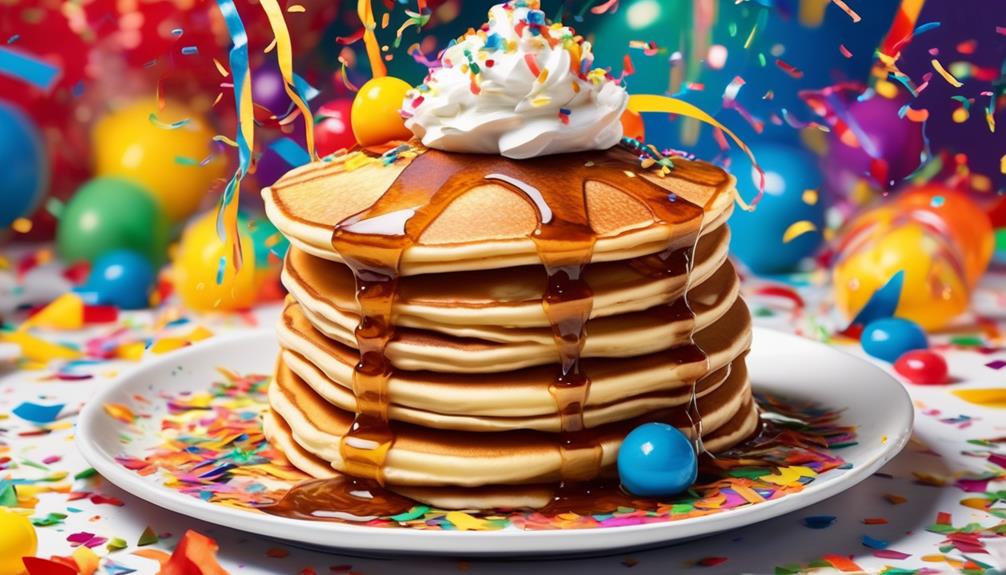
Have you ever wondered what you’re supposed to do on Shrove Tuesday? It’s a day filled with traditions and customs that may seem a bit mysterious at first, but they all have deep-rooted significance.
From the making of pancakes to engaging in acts of repentance, Shrove Tuesday offers a diverse range of activities that hold both historical and religious importance.
But what exactly are these traditions, and why do people partake in them? Let's explore the meaningful customs and practices associated with Shrove Tuesday to gain a better understanding of this widely celebrated day.
Key Takeaways
- Shrove Tuesday, also known as Pancake Day, marks the transition from Carnival to Lent and is celebrated with traditions such as pancake races and tossing competitions.
- Traditional pancake recipes have been passed down through generations, and the key to a perfect pancake lies in the balance of flour, eggs, milk, and salt.
- Participating in Carnival celebrations on Shrove Tuesday involves vibrant parades, costume parties, and a sense of unity and camaraderie among participants.
- Attending church services on Shrove Tuesday, whether it's Ash Wednesday services or special gatherings, prepares for the Lenten season and offers opportunities for spiritual growth, reflection, and renewal.
Origins of Shrove Tuesday
Shrove Tuesday, also known as Pancake Day, has its origins in the Christian tradition as a day of feasting and the last day before the start of Lent. It's a time when we come together to indulge in rich and decadent foods before the solemn period of Lent begins. The history of pancakes on this day is rooted in the desire to use up rich ingredients like eggs, milk, and sugar before the fasting period. Pancakes became symbolic of this frugal and practical approach to cooking, and over time, they became an integral part of Shrove Tuesday traditions.
For centuries, Shrove Tuesday customs have revolved around the making and consuming of pancakes, with communities organizing pancake races and pancake tossing competitions. It's a day that holds great significance for us, as it marks the transition from the revelry of Carnival to the introspection of Lent. As a community, we cherish the traditions of Shrove Tuesday, celebrating the joyous feasting and camaraderie that comes with it.
The shared experience of preparing and enjoying pancakes binds us together in a joyful celebration of abundance before the austerity of Lent.
Traditional Pancake Making

As we celebrate the rich traditions of Shrove Tuesday, let's now explore the art of traditional pancake making. Making pancakes the traditional way is a cherished practice in many households. Our family has passed down traditional recipes for generations, and there's something special about using the same ingredients and methods that our ancestors did. The key to a perfect traditional pancake lies in the simplicity of the recipe. It's all about finding the right balance of flour, eggs, milk, and a pinch of salt. As we mix the batter, we reminisce about the stories behind these recipes, adding a sense of nostalgia to the process.
When it comes to the flipping technique, it's a skill that takes time to master. The secret is in the wrist motion, gently sliding the spatula under the pancake and swiftly flipping it over. It's a moment of anticipation as we wait for that perfect golden brown color to appear. There's a sense of accomplishment in getting that flip just right, a feeling that connects us to the countless others who've perfected this art before us.
Participating in Carnival Celebrations
We eagerly join in the vibrant Carnival celebrations, immersing ourselves in the colorful parades and festive atmosphere. The energy of the Carnival parades is infectious, with lively music and dancers filling the streets. It's a time of pure joy and freedom, where we can let loose and be part of something truly exhilarating. The costume parties are a highlight, as we put on our most elaborate and creative outfits, expressing ourselves in ways we wouldn't normally. The sense of unity and camaraderie during Carnival is palpable, as people from all walks of life come together to revel in the spirit of the occasion. It's a time when we can shed our inhibitions and simply enjoy the moment without any reservations.
| Emotions | Description |
|---|---|
| Excitement | The anticipation of the colorful parades and lively music fills us with joy. |
| Liberation | Wearing eccentric costumes allows us to break free from societal norms and express our true selves. |
| Togetherness | The sense of unity and camaraderie during Carnival fosters a feeling of belonging and inclusivity. |
| Celebration | The festive atmosphere and exuberant energy create an atmosphere of pure joy and merriment. |
Attending Church Services

We believe attending church services on Shrove Tuesday is a meaningful way to prepare for the Lenten season.
It's important to consider the different types of church services available, such as Ash Wednesday services or special Shrove Tuesday gatherings.
Participating in prayers and seeking spiritual guidance can help us observe this day in a reflective and meaningful manner.
Church Service Importance
Gathering together for church services on Shrove Tuesday is a meaningful tradition for many communities. The importance of this gathering extends beyond the religious significance. It fosters community involvement, bringing people together in a shared spiritual experience.
Attending church services on this day provides an opportunity for spiritual growth, reflection, and renewal. It's a time to come together, support one another, and seek guidance for the Lenten season ahead. The significance of participating in these services lies in the sense of unity and belonging it brings to the community.
Through worship, prayer, and fellowship, individuals find solace and strength. It's a chance to reaffirm our shared values and commitment to our faith. So, attending church services on Shrove Tuesday isn't just a tradition; it's an essential part of our communal and spiritual journey.
Types of Church Services
Church services on Shrove Tuesday typically include special liturgies, communal prayers, and reflections to prepare for the Lenten season. When considering service options, it's essential to explore different worship styles that resonate with our spiritual journey.
Here are some worship styles to consider:
- Traditional services: These services usually follow a formal structure, including hymns, readings, and liturgical elements, providing a sense of reverence and continuity with the church's history.
- Contemporary services: These services often incorporate modern music, multimedia elements, and interactive components, offering a more casual and accessible worship experience.
- Ecumenical services: These services bring together members of different Christian denominations to celebrate unity in diversity, embracing various traditions and practices.
Exploring these service options can enrich our spiritual experience and help us connect with the community in meaningful ways.
Participating in Prayers
When considering our participation in prayers, we can explore different church services that resonate with our spiritual journey and provide meaningful ways to connect with the community.
Participating in prayers at church not only nourishes our spiritual reflection but also offers a sense of community support. Attending regular church services allows us to engage in collective prayers, seek guidance from spiritual leaders, and find comfort in the shared experience of faith.
Whether it's a contemplative midweek service, a lively Sunday worship, or a special prayer gathering, each service provides an opportunity to come together with others who are also seeking spiritual fulfillment.
Engaging in Acts of Repentance

As we prepare for Shrove Tuesday, engaging in acts of repentance becomes a focal point of our observance. Repentance through fasting, seeking forgiveness sincerely, and reflecting on past actions are integral to this process.
These acts provide an opportunity for us to renew our commitment to spiritual growth and seek reconciliation with both ourselves and others.
Repentance Through Fasting
Engaging in acts of repentance through fasting provides an opportunity for spiritual reflection and renewal. Fasting benefits our spiritual growth by allowing us to cultivate self-discipline and self-control, enabling us to resist temptation and grow in our faith. It also heightens our awareness of our dependence on God, deepening our connection with Him and fostering a spirit of humility. Additionally, fasting helps us refocus our priorities and realign our hearts with God's will, creating space for spiritual growth and transformation.
Through fasting, we intentionally set aside physical desires to seek God wholeheartedly, fostering a deeper intimacy with Him. It's a time to cleanse our hearts, seek forgiveness, and renew our commitment to living in accordance with God's word. As we engage in acts of repentance through fasting, we open ourselves to God's transformative work within us.
Seeking Forgiveness Sincerely
Seeking forgiveness sincerely is a fundamental aspect of engaging in acts of repentance, allowing us to reconcile with God and others and experience spiritual renewal. It involves personal reflection, acknowledging our wrongdoings, and expressing genuine remorse.
When we seek forgiveness, we open our hearts to the transformative power of repentance. It requires us to confront our shortcomings, take responsibility for our actions, and make amends with sincerity. Through seeking forgiveness, we actively engage in the process of self-examination and growth, fostering humility and empathy.
It's a deeply personal and introspective journey that leads to healing and restoration. By approaching forgiveness with humility and genuine contrition, we pave the way for reconciliation and spiritual renewal, both within ourselves and in our relationships with others.
Reflecting on Past Actions
Reflecting on our past actions involves honest self-examination and a willingness to take responsibility for our wrongdoings, paving the way for genuine repentance and spiritual growth. Engaging in self-reflection allows us to acknowledge our past mistakes and understand that they're learning opportunities, not defining moments.
Through this process, we can seek personal growth by actively working to make amends and change for the better. This involves embracing our imperfections and recognizing the areas in which we need to improve. It requires us to confront our shortcomings with humility and openness, allowing us to move forward with a renewed sense of purpose and a commitment to learning from our past missteps.
- Acknowledge our past mistakes
- Embrace imperfections with humility
- Commit to personal growth through self-reflection
Donating to Charity
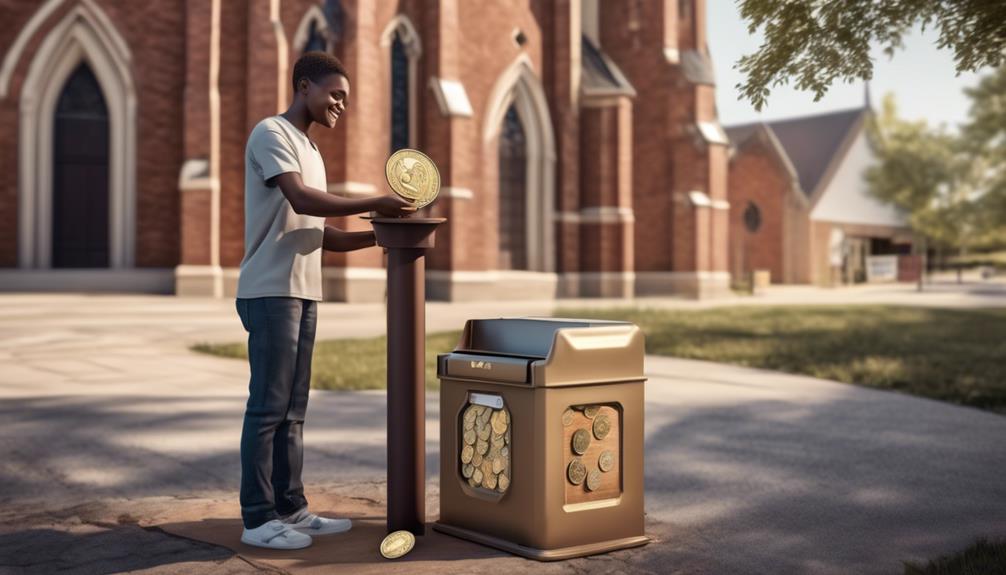
On Shrove Tuesday, let's consider giving back to our community by donating to charity. It's a wonderful opportunity to make a meaningful difference in the lives of those in need.
Many charitable organizations rely on the generosity of volunteers and donors to support their causes. Whether it's contributing financially, offering your time, or donating goods, there are various ways to get involved.
Consider researching local charities and finding out what specific items or services they need. It could be as simple as donating non-perishable food items, clothes, or household essentials.
Additionally, many charities have volunteer opportunities that allow you to directly impact the community. Volunteering not only helps those in need, but it also provides a sense of fulfillment and purpose.
By participating in charity donations and volunteer work, we can create a positive impact on Shrove Tuesday, fostering a culture of giving and compassion within our community.
Let's come together and make a difference this Shrove Tuesday.
Enjoying Family Time and Festivities
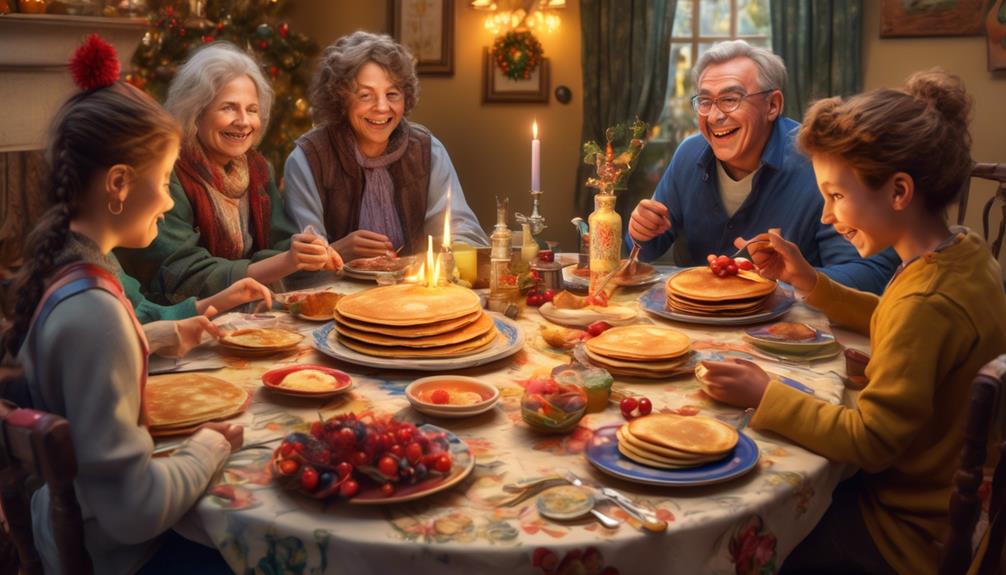
Let's gather with our loved ones and take part in the joyous festivities of Shrove Tuesday. This special day is all about coming together as a community and celebrating with our families.
Here are a few ways to enjoy this time of family bonding and community festivities:
- Pancake Making: Get everyone involved in making and flipping pancakes. It's a fun activity that brings laughter and joy to the kitchen.
- Festive Decorations: Spend time decorating the house with colorful banners, streamers, and balloons. It's a simple way to create a festive atmosphere and bond as a family.
- Outdoor Games: Organize outdoor games such as sack races or egg and spoon races. These activities promote friendly competition and create lasting memories for the whole family.
As we engage in these activities, we strengthen our bonds with our loved ones and create cherished moments that will be remembered for years to come.
Frequently Asked Questions
What Are the Origins of the Name "Shrove Tuesday"?
Origins of the name 'Shrove Tuesday' stem from the word 'shrive,' meaning to confess. It's a day of preparation before Lent, a time to confess sins and seek absolution.
This tradition led to the custom of using up rich foods like eggs and milk in pancakes before the Lenten fast.
Pancake races and Mardi Gras celebrations have become associated with this day, adding to its festive nature.
How Do Different Cultures Around the World Celebrate Shrove Tuesday?
We love exploring Carnival traditions worldwide; it's fascinating! Different cultures celebrate with unique flair, preparing for Lent in colorful ways. From vibrant parades to religious customs, the diversity is captivating.
And let's not forget the delightful global pancake variations—each one a delicious reflection of local tastes. The festive spirit is infectious, drawing us in and leaving us eager to learn more about the beautiful traditions of Shrove Tuesday.
What Are Some Traditional Pancake Toppings or Fillings?
When it comes to traditional pancake toppings or fillings, the options are endless. For a sweet twist, we love classic choices like maple syrup, berries, or chocolate spread.
But if savory is more your style, consider options like bacon, cheese, or eggs. It's all about personal preference.
And let's not forget the joy of having breakfast for dinner – it's a fun and delicious way to mix things up at the table.
Is There a Specific Type of Charity or Organization That People Typically Donate to on Shrove Tuesday?
Charity donations on Shrove Tuesday often support religious traditions and local community needs. Many people contribute to organizations that help those in need, such as food banks, homeless shelters, or community outreach programs.
The act of giving back during this time allows us to embody the spirit of generosity and compassion, reflecting the values of the season. It's a meaningful way for us to connect with our community and support those who may be struggling.
How Can Families Incorporate Acts of Repentance Into Their Shrove Tuesday Celebrations?
Incorporating acts of repentance into our Shrove Tuesday celebrations is a meaningful way for families to connect with their faith.
We often start the day with a prayer or reflection on our past actions, followed by a discussion on how we can seek forgiveness and make amends.
This sets the tone for the day and helps us focus on the significance of the upcoming Lenten season.
It's a beautiful tradition that brings us closer together as a family.
Conclusion
In conclusion, on Shrove Tuesday, we participate in traditional pancake making, attend church services, and engage in acts of repentance.
We also enjoy carnival celebrations, donate to charity, and spend quality time with family.
Shrove Tuesday is a time for feasting, fun, and faith, where we focus on forgiveness and fellowship.
So, whether you're flipping flapjacks or finding forgiveness, make the most of this marvelous, meaningful day.
- About the Author
- Latest Posts
Introducing Ron, the home decor aficionado at ByRetreat, whose passion for creating beautiful and inviting spaces is at the heart of his work. With his deep knowledge of home decor and his innate sense of style, Ron brings a wealth of expertise and a keen eye for detail to the ByRetreat team.
Ron’s love for home decor goes beyond aesthetics; he understands that our surroundings play a significant role in our overall well-being and productivity. With this in mind, Ron is dedicated to transforming remote workspaces into havens of comfort, functionality, and beauty.
-

 Vetted4 weeks ago
Vetted4 weeks ago15 Best Contact Paper for Kitchen Cabinets to Elevate Your Home Decor
-

 Vetted2 weeks ago
Vetted2 weeks ago15 Best Poe Cameras for Home Security – Reviews & Buying Guide
-

 Vetted4 weeks ago
Vetted4 weeks ago15 Best Drain Snakes to Unclog Your Pipes Like a Pro
-

 Beginners Guides7 days ago
Beginners Guides7 days agoI Inhaled Vinegar Fumes
-

 Vetted4 weeks ago
Vetted4 weeks ago14 Best Stationery Brands for Your Next Writing Adventure
-

 Beginners Guides3 weeks ago
Beginners Guides3 weeks agoSwinger Porch Light Color
-

 Mardi Gras Decoration4 weeks ago
Mardi Gras Decoration4 weeks agoWhy Does Hobby Lobby Not Do Mardi Gras?
-

 Vetted2 weeks ago
Vetted2 weeks ago15 Best Blinds for Bathroom Windows to Enhance Privacy and Style









![Best Ceiling Fans with Lights and Remote for Modern Homes [2024] 227 51uZ2eDH4KL 1](https://byretreat.com/wp-content/uploads/2023/11/51uZ2eDH4KL-1-80x80.jpg)

![Best White Ceiling Fans for Modern Homes [2024] 229 41su1OWC2YL](https://byretreat.com/wp-content/uploads/2023/11/41su1OWC2YL-80x80.jpg)






![Best Ceiling Fans with Lights and Remote for Modern Homes [2024] 266 51uZ2eDH4KL 1](https://byretreat.com/wp-content/uploads/2023/11/51uZ2eDH4KL-1-400x240.jpg)
![Best White Ceiling Fans for Modern Homes [2024] 268 41su1OWC2YL](https://byretreat.com/wp-content/uploads/2023/11/41su1OWC2YL-400x240.jpg)



![Best Puerto Rican Christmas Decorations: Traditional and Festive Ornaments to Deck the Halls [2024] 272 91Dg93uApyL](https://byretreat.com/wp-content/uploads/2023/11/91Dg93uApyL-80x80.jpg)